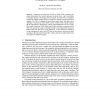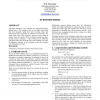241 search results - page 4 / 49 » Trace analysis of Erlang programs |
CAL
2006
13 years 6 months ago
2006
Instruction-level traces are widely used for program and hardware analysis. However, program traces for just a few seconds of execution are enormous, up to several terabytes in siz...
PLDI
2009
ACM
14 years 6 months ago
2009
ACM
As computer systems continue to become more powerful and comdo programs. High-level abstractions introduced to deal with complexity in large programs, while simplifying human reas...
RV
2010
Springer
13 years 4 months ago
2010
Springer
Abstract. Concurrent trace programs (CTPs) are slices of the concurrent programs that generate the concrete program execution traces, where inter-thread event order specific to th...
SIGMETRICS
1999
ACM
13 years 10 months ago
1999
ACM
ded Abstract This paper introduces a new technique for compressing memory address traces. The technique relies on the simple observation that most programs spend their time execut...
ISSRE
2002
IEEE
13 years 11 months ago
2002
IEEE
Tracing is a dynamic analysis technique to continuously capture events of interest on a running program. The occurrence of a statement, the invocation of a function, and the trigg...


